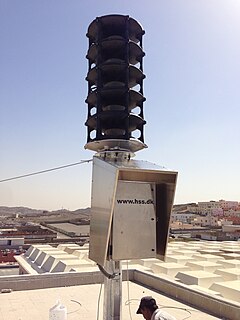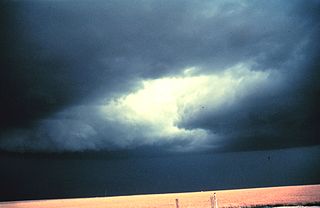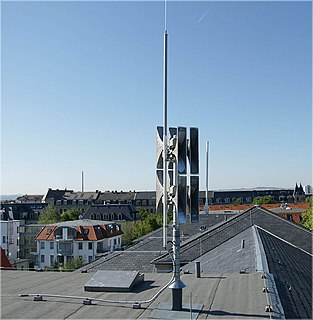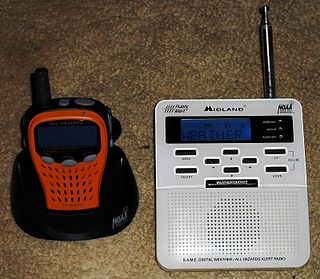Related Research Articles

A civil defense siren is a siren used to provide an emergency population warning to the general population of approaching danger. It is sometimes sounded again to indicate the danger has passed. Some sirens are also used to call the volunteer fire department when needed. Initially designed to warn city dwellers of air raids in World War II, they were later used to warn of nuclear attack and natural destructive weather patterns such as tornadoes. The generalized nature of sirens led to many of them being replaced with more specific warnings, such as the broadcast-based Emergency Alert System and the Cell Broadcast-based Wireless Emergency Alerts and EU-Alert mobile technologies.

The Federal Emergency Management Agency (FEMA) is an agency of the United States Department of Homeland Security (DHS), initially created under President Jimmy Carter by Presidential Reorganization Plan No. 3 of 1978 and implemented by two Executive Orders on April 1, 1979. The agency's primary purpose is to coordinate the response to a disaster that has occurred in the United States and that overwhelms the resources of local and state authorities. The governor of the state in which the disaster occurs must declare a state of emergency and formally request from the President that FEMA and the federal government respond to the disaster. The only exception to the state's gubernatorial declaration requirement occurs when an emergency or disaster takes place on federal property or to a federal asset—for example, the 1995 bombing of the Alfred P. Murrah Federal Building in Oklahoma City, Oklahoma, or the Space Shuttle Columbia in the 2003 return-flight disaster.

The Emergency Alert System (EAS) is a national warning system in the United States designed to allow authorized officials to coordinate and disseminate emergency alerts and warning messages to the public via terrestrial and satellite radio and television, including broadcast and multichannel television.

A tornado warning is a severe weather warning product issued by regional offices of weather forecasting agencies throughout the world to alert the public when a tornado has been reported or indicated by weather radar within the parent severe thunderstorm. It can be issued after a tornado, funnel cloud and rotation in the clouds has been witnessed by the public, storm chasers, emergency management or law enforcement, and indicates that residents in the affected areas should take immediate safety precautions.

A severe thunderstorm warning is a severe weather warning product issued by regional offices of weather forecasting agencies throughout the world to alert the public that severe thunderstorms are imminent or occurring. A severe thunderstorm warning is issued when Doppler weather radar, trained storm spotters or local emergency management personnel indicate that a thunderstorm is producing large hail and high winds capable of causing significant damage, and is expected to continue producing severe weather along the storm's projected track. Flooding is also sometimes caused by torrential rainfall produced by a thunderstorm.

The National Weather Service (NWS) is an agency of the United States federal government that is tasked with providing weather forecasts, warnings of hazardous weather, and other weather-related products to organizations and the public for the purposes of protection, safety, and general information. It is a part of the National Oceanic and Atmospheric Administration (NOAA) branch of the Department of Commerce, and is headquartered in Silver Spring, Maryland, within the Washington metropolitan area. The agency was known as the United States Weather Bureau from 1890 until it adopted its current name in 1970.

NOAA Weather RadioNWR; also known as NOAA Weather Radio All Hazards is an automated 24-hour network of VHF FM weather radio stations in the United States (U.S.) that broadcast weather information directly from a nearby National Weather Service office. The routine programming cycle includes local or regional weather forecasts, synopsis, climate summaries or zone/lake/coastal waters forecasts. During severe conditions the cycle is shortened into: hazardous weather outlooks, short-term forecasts, special weather statements or tropical weather summaries. It occasionally broadcasts other non-weather related events such as national security statements, natural disaster information, environmental and public safety statements, civil emergencies, fires, evacuation orders, and other hazards sourced from the Federal Communications Commission's (FCC) Emergency Alert System. NOAA Weather Radio uses automated broadcast technology that allows for the recycling of segments featured in one broadcast cycle seamlessly into another and more regular updating of segments to each of the transmitters. It also speeds up the warning transmitting process.
The Common Alerting Protocol (CAP) is an XML-based data format for exchanging public warnings and emergencies between alerting technologies. CAP allows a warning message to be consistently disseminated simultaneously over many warning systems to many applications, such as Google Public Alerts and Cell Broadcast. CAP increases warning effectiveness and simplifies the task of activating a warning for responsible officials.

An emergency population warning is a method whereby local, regional, or national authorities can contact members of the public en masse to warn them of an impending emergency. These warnings may be necessary for a number of reasons, including:

Emergency management is the organization and management of the resources and responsibilities for dealing with all humanitarian aspects of emergencies. The aim is to prevent and reduce the harmful effects of all hazards, including disasters.

A weather radio is a specialized radio receiver that is designed to receive a public broadcast service, typically from government-owned radio stations, dedicated to broadcasting weather forecasts and reports from the National Weather Service on a continual basis, with the routine weather reports being interrupted by emergency weather reports whenever needed. Weather radios are typically equipped with a standby alerting function—if the radio is muted or tuned to another band and a severe weather bulletin is transmitted, it can automatically sound an alarm and/or switch to a pre-tuned weather channel for emergency weather information.
Comprehensive emergency management, as defined in various laws throughout the United States, is the preparation for and the carrying out of all emergency functions, other than functions for which the military forces are primarily responsible, to mitigate, prepare for, respond to, and recover from emergencies and disasters, and to aid victims suffering from injury or damage, resulting from disasters caused by all hazards, whether natural, technological, or human caused, and to provide support for search and rescue operations for persons and property in distress.
The Digital Emergency Alert System (DEAS) was a system managed by the Federal Emergency Management Agency (FEMA) and designed to alert first-responders and civilians in the event of a national emergency. It was based upon and supplemented the Emergency Alert System (EAS) by sending out text, voice, video, and other digital messages to mobile phones, pagers, radios, and televisions.

The Oklahoma Department of Emergency Management (OEM) is a department of the government of Oklahoma responsible for coordinating the response to a natural disaster that has occurred in the State and that has overwhelmed the abilities of local authorities. This is achieved primarily through the development and maintenance of a comprehensive statewide emergency management plan. OEM is responsible for coordinating the efforts of the federal government with other state departments and agencies, county and municipal governments and school boards, and with private agencies that have a role in emergency management.
A flood warning is closely linked to the task of flood forecasting. The distinction between the two is that the outcome of flood forecasting is a set of forecast time-profiles of channel flows or river levels at various locations, while "flood warning" is the task of making use of these forecasts to make decisions about whether warnings of floods should be issued to the general public or whether previous warnings should be rescinded or retracted.
The HEARO Local Alert Receiver was an emergency management tool to relay and display informational text messages in English, Spanish, French and German using RDS technology. It notified local residents in the event of an emergency within a matter of seconds. HEARO carried NOAA weather warnings and other public safety text alerts, using FM radio infrastructure with a 60-hour battery life, HEARO was able to work when electricity, telephone and Internet were unavailable. viaRadio Corporation of Melbourne, Florida manufactured and distributed HEARO receivers.

Wireless Emergency Alerts, is an alerting network in the United States designed to disseminate emergency alerts to mobile devices such as cell phones and pagers. Organizations are able to disseminate and coordinate emergency alerts and warning messages through WEA and other public systems by means of the Integrated Public Alert and Warning System.
The Integrated Public Alert and Warning System (IPAWS) is an architecture that unifies the United States' Emergency Alert System, National Warning System, Wireless Emergency Alerts, and NOAA Weather Radio, under a single platform. IPAWS was designed to modernize these systems by enabling alerts to be aggregated over a network and distributed to the appropriate system for public dissemination.
ALERT FM is an emergency notification system that delivers messages from state, local, and/or private sector officials to citizens, schools, businesses, and first responders using the Radio Data System of local FM radio stations. Messages are transported from a secure web-based portal to the data sub-carrier via GSSNet, a satellite data delivery system. These alerts and messages are then received on ALERT FM receivers or on cell phones equipped with active FM chips and properly installed software.
There are various Wireless Emergency Alerts in Germany which inform citizens about important incidents, disasters and dangerous situations, as well as severe weather. Since February 2019, the alerts of the three main systems have been shared and disseminated in parallel.
References
- 1 2 3 National Warning System Operations Manual – FEMA, 30 Mar 2001
- ↑ "Integrated Public Alert & Warning System". fema.gov. Federal Emergency Management Agency. September 18, 2018. Retrieved September 22, 2018.
IPAWS provides public safety officials with an effective way to alert and warn the public about serious emergencies using the Emergency Alert System (EAS), Wireless Emergency Alerts (WEA), the National Oceanic and Atmospheric Administration (NOAA) Weather Radio, and other public alerting systems from a single interface.
- ↑ Emergency Alert System Update Archived 2014-02-28 at the Wayback Machine – Martin Bongers,Project Officer, Integrated Public Alert and Warning System, Federal Emergency Management Agency (FEMA)